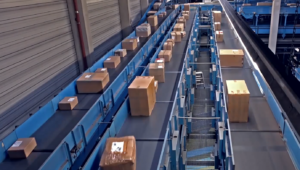
Inside the Analytic Transformation of Pitney Bowes

Who is Pitney Bowes? For some, the 96-year-old company is synonymous with 20th century technology, like mailing machines and postage meters. But after Tuesday’s launch of its new Commerce Cloud, it’s clear the company sees its future helping small and midsize businesses better navigate the global commerce, with data and analytics playing key roles.
Tuesday’s launch of the Commerce Cloud is the culmination of several years of work to remake Pitney Bowes (NYSE: PTI) into a modern digital organization. Yes, the $3.5-billion, Connecticut-based concern still sells and services huge mailing machines, called inserters, and postage machines to some of the country’s biggest organizations. But with mail volume in the U.S. down 28 percent over past decade, the company is in need of a transformation. This is where data, analytics, and Web-based services come into play.
Pitney Bowes Chief Innovation Officer Roger Pilc spoke with Datanami about the new Commerce Cloud launched Tuesday and what it means to the company’s overall strategy, and in particular its intent to leverage data and analytics to bolster shipping and mailing solutions to SMBs.
Four of Pitney Bowes business lines will have cloud aspects. Three of them–cross-border ecommerce, SMB solutions, and enterprise solutions—are directly related to shipping and mailing, while the fourth, location intelligence, is purely about data.
The company intends to grease the wheels of international commerce from the cloud, and data analytics will play a major role, he says. “We’re essentially an Uber for cross-border ecommerce parcels,” Pilc says. “If you’re selling something on Ebay (NASDAQ: EBAY), say a baby stroller, our software, through machine learning, will classify it into intentional codes. There are millions of category need to be classified correctly.
“Then we have a network of shippers in 100 countries,” he continues. “Based on the classification and weight, we calculate and predict fully landed costs–including shipping, duties, taxes, and import fees. We’ve gotten so good at it through the analytics and machine learning over time that we can guarantee that shipping cost.”
The company has grown its ecommerce business considerably over the past few years, and today it’s managing more than $2 billion in merchandise annually, Pilc says. The cloud environment should streamlines access to the service, giving SMBs a streamlined way to interface with shippers and their own customers.

(archerix/Shutterstock)
“It helps buyers and sellers by being able to be explicit and guarantee cost,” he says. “It gets a huge source of friction out of ecommerce. One of the biggest reasons people drop their shopping cart is when they see the shipping cost.”
Putting all this shipping and location data on Amazon Web Services cloud makes a lot of sense, from Pitney Bowes’ perspective. “The benefits to the clients of this approach are many,” Pilc says. “By bringing it together and putting it through a common API management platform and normalizing and standardizing how we can get access, it helps us deliver solutions, such as the one we announced today around SendPro.”
The enterprise inserter and SMB mailing businesses will also be hooked into the Commerce Cloud. Customers will not only be able to access subscriptions to geo-coding and address verification solutions over the Internet, but they’ll be able to send Pitney Bowes data about the pending failure of hardware components, such as postage machines, which will improve customer service. In this manner, Pilc says, Pitney Bowes is behaving like Nest, the smart thermostat manufacturer bought by Google (NASDAQ: GOOG).
The cloud also minimizes data movement and makes it easier for the company’s engineers, developers, and data scientists to access the data. The company is storing much of its unstructured data on Amazon’s Elastic MapReduce (EMR) service. In addition to using the data to drive analytics that bolster its own shipping automation business, Pitney Bowes’ collects data for its own sake, and sells it to various customers, who can do their own analytics on it.
“We have a pretty large data business today in terms of selling data solutions to customers. We have 300-plus data sets driving tens in millions [of dollars] in revenues,” Pilc says. “We have, over the course of the past couple of years, expanded the data sets available in Commerce Cloud data platform. Right now there are 50 data sets.”
Pitney Bowe’s location services is used by a range of companies, including social media companies to target advertising more effectively provide targeted advertising, and insurance companies to minimize underwriting risk.
Pilc expects its Hadoop-based big data environment to get bigger over time. “We’re certainly expecting it to grow into the tens of petabytes,” he says. “It’s both proprietary data we’re originating and proprietary data from vendors of ours that we ingest, and also public data.”
 Whether customers want raw data or finished insights, the Commerce Cloud will play host to much of the underlying data. “The market is evolving such that customer are increasingly wanting insights and solution that solve a business problem so they don’t have to do the work,” Pilc says. “We’re launching this quarter a set of geo-enrichment solutions where we’ll take the data–and the underlying geo-demographic data, point of interest data, or address data–and we’ll do the analytics on it for our customer so they don’t have to, and we’ll enrich that data for them.”
Whether customers want raw data or finished insights, the Commerce Cloud will play host to much of the underlying data. “The market is evolving such that customer are increasingly wanting insights and solution that solve a business problem so they don’t have to do the work,” Pilc says. “We’re launching this quarter a set of geo-enrichment solutions where we’ll take the data–and the underlying geo-demographic data, point of interest data, or address data–and we’ll do the analytics on it for our customer so they don’t have to, and we’ll enrich that data for them.”
The company is using a standard set of tools to analyze the data, from including R and visualization tools from Tableau (NYSE: DATA). “The team has gotten surprisingly good at machine learning,” he says. “I say surprisingly, because it’s amazing how fast our teams are growing and learning in their ability. We’ve trained over 90 of our staff on machine learning in the last 6 months.”
Pilc says he’s seeing an “incredible hunger and thirst” for learning about data analytics at Pitney Bowes. “We embarked on this journey three years ago and at this point have trained almost half of our 1,200 engineers on modern technologies in the areas we’re talking about—advanced analytics, machine learning, big data, IoT, cloud– and the response in our company has been absolutely tremendous,” he says. “Our competency in these areas have grown in very gratifying ways.”
Related Items:
5 Ways Big Geospatial Data Is Driving Analytics In the Real World
Predictive Analytics, Visualization Enlisted in Crime Fight






























